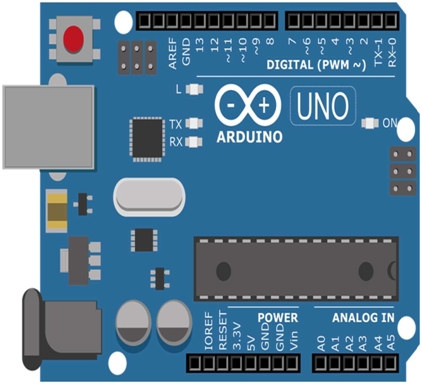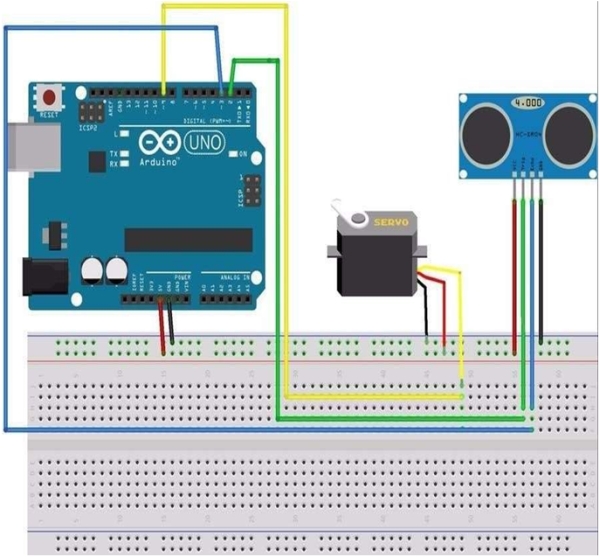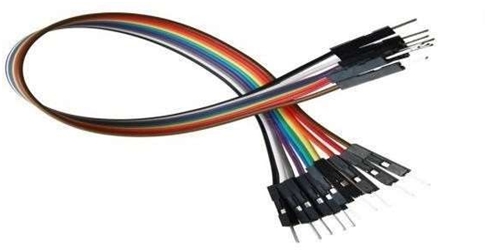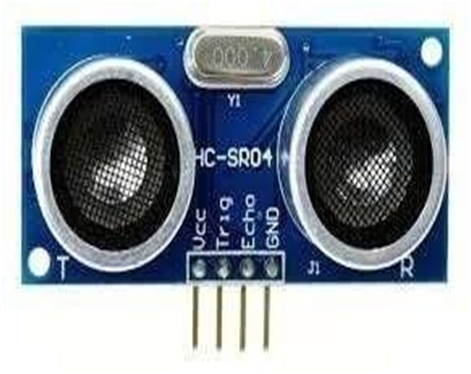Introduction
Radar technology is commonly used for applications like weather monitoring, air traffic control, and object detection. However, traditional radar systems can be complex and expensive to implement. This project explores an accessible alternative approach using an Arduino microcontroller and ultrasonic sensors for basic object detection capabilities.

Components and Materials
Arduino Uno board
HC-SR04 ultrasonic sensor module
Breadboard
Male to male jumper wires
9V battery & battery clip

System Design
The ultrasonic sensor is connected to pin triggers on the Arduino. It emits an 8 cycle sonic burst from the trigger pin and detects the echo return on the echo pin. We use the pulse In function to measure the echo duration. Distance is calculated using the speed of sound.

Software Development
The Arduino code triggers the ultrasonic sensor, measures the echo duration, and uses it to calculate distance to the nearest object. It prints the distance value to the serial monitor for observation.
Assembly and Testing
We assemble the circuit on a breadboard per the wiring diagram. The power, ground, trigger and echo pins are correctly connected. Upon uploading the code, the ultrasonic sensor generates readings which are visible on the serial monitor, demonstrating it is functioning properly.

Results and Discussion
The system detects objects from 2cm to 450cm away. Accuracy depends on surface reflectivity. Variations can occur depending on environmental factors like temperature and humidity.
Considerations and Enhancements
To improve range and detection area, we could experiment with different sensor models or rotate the sensor with a servo motor. Integrating an LCD display or LED indicators could visualize distance data. Adding infrared or image sensors could enable more complex object recognition capabilities.

Conclusion
This project presented a low-cost alternative to traditional radar technology using readily available Arduino and ultrasonic components. The basic object detection capabilities achieved provide a platform to explore further applications in fields like robotics. With enhancements, more sophisticated detection and sensing functions could be realized on top of this introductory system design and programming.
Component Selection
Evaluate different ultrasonic sensor modules with varying ranges/accuracy
Consider an Arduino with more I/O pins for additional sensors
Distance Measurements
Evaluate measurement variability at different distances Determine optimal sampling frequency for desired range/resolution
Directional Detection
Interface sensor with servo motor and code for full 360° rotation Scan and build a ‘picture’ of surrounding objects
Data Visualization
Display distance readings on LCD or plot a chart on computer
Use LED bar graph or individual LEDs to indicate proximity
Advanced Object Recognition
Add passive infrared sensor for motion detection
Interface camera and apply image processing for visual recognition
Explore machine learning to classify objects beyond distance
Enclosure Design
Prototype 3D printed enclosure for integrated standalone system
Consider mobility with addition of wheels/motor for robotics uses
Applicability
Discuss potential real world applications like smart factories, warehouses
Assess feasibility for consumer products like automated vacuums, toys
Future Work
Develop Android/IoT connectivity for monitoring over WiFi/Bluetooth
Integrate distance and image data for advanced obstacle avoidance
Fabricate PCB for compact commercial-grade sensor module design
So in summary, there are many avenues to explore enhancing capabilities, optimizing performance, expanding applicability and paving the way for more advanced object sensing projects.
Multi-Sensor Integration
Combine ultrasonic sensor with additional sensors like passive infrared, microwave or even a small camera. This allows for things like motion detection, material differentiation and visual identification.
Synchronize multiple ultrasonic sensors pointing in different directions to build a more complete spatial picture of the environment.
Distance Measurement Precision
Experiment with different trigger and echo ping timing intervals to improve distance measurement accuracy at very close or extremely long ranges.
Evaluate noise reduction techniques like averaging multiple readings to reduce fluctuations.
Directional Detection Algorithms
Develop algorithms to interpret sensor scan data and build a live multi-dimensional map of object positions around the radar unit.
Track moving objects by comparing maps over time.
Data Visualization:
Stream sensor readings over WiFi to a mobile app or web interface for remote monitoring.
Implement 3D object rendering based on scan data maps for an intuitive spatial view.
Machine Learning Integration
Gather labeled dataset of common objects and distances during operation.
Train a ML model to identify and classify objects based on their sensor signatures.
Advanced Applications
Integrate radar with servos/motors to build an autonomous inspection drone or warehouse inventory robot.
Add complex obstacle avoidance and path planning algorithms for mobility.
Commercialization Pathways
Consider patenting novel sensing array or algorithm designs.
Partner with electronics manufacturers for hardware and software customization for industrial/commercial products.
So in summary, there is a huge potential to evolve this introductory Arduino radar into an extremely sophisticated sensing and perception system through extensive experimentation and new technological integrations.
Distributed Sensor Networks
Connect multiple radar units together using communication protocols like LoRa WAN to create a distributed sensing grid for large indoor/outdoor areas.
Synchronize data collection and processing for integrated spatial awareness over a wide region.
Environmental Adaptation
Add temperature, humidity and atmospheric pressure sensors to compensate measurements for changing conditions.
Experiment with waterproof enclosures and materials for reliable outdoor/harsh environment use.
Sensor Fusion
Combine radar data with other sensors like GPS, IMU, vision for multi-modal perception.
Integrate with drones, robots etc for autonomous navigation relying on merged inputs.
Algorithm Optimization
Develop advanced signal processing techniques like FFT, wavelet analysis etc to refine distance readings from ultrasonic echoes.
Implement particle filters, Kalman filters for optimizing object tracking over time.
Cybersecurity Features
Add authentication and encryption to the wireless communication protocols.
Implement mechanisms for detecting interference/spoofing of sensing data for safety critical applications.
Product Roadmap
Gradually enhance features and build product portfolio – entry level kits, industrial grade modules, integration services etc.
Consider crowd-funding campaigns and piloting with early customers for iterative feedback.
So in summary, there are unlimited possibilities to upgrade this platform into robust, scalable and highly intelligent perception systems supporting a wide variety of industrial and research applications through continuous innovation.
Follow this link for complete project: Arduino-Based Object Detection System
